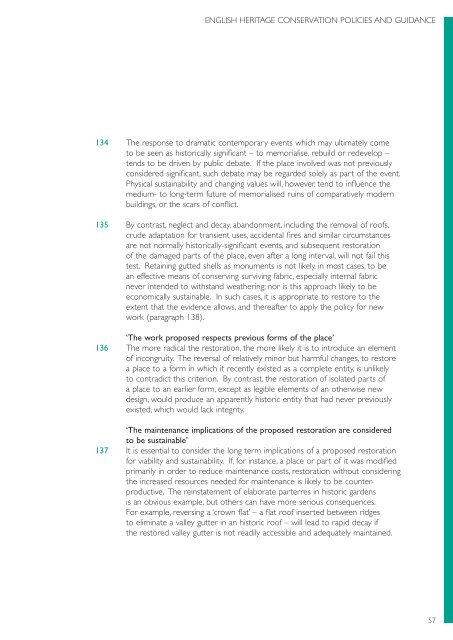Conservation Principles, Policies and Guidance - English Heritage
Conservation Principles, Policies and Guidance - English Heritage
Conservation Principles, Policies and Guidance - English Heritage
Create successful ePaper yourself
Turn your PDF publications into a flip-book with our unique Google optimized e-Paper software.
ENGLISH HERITAGE CONSERVATION POLICIES AND GUIDANCE<br />
134 The response to dramatic contemporary events which may ultimately come<br />
to be seen as historically significant – to memorialise, rebuild or redevelop –<br />
tends to be driven by public debate. If the place involved was not previously<br />
considered significant, such debate may be regarded solely as part of the event.<br />
Physical sustainability <strong>and</strong> changing values will, however, tend to influence the<br />
medium- to long-term future of memorialised ruins of comparatively modern<br />
buildings, or the scars of conflict.<br />
135 By contrast, neglect <strong>and</strong> decay, ab<strong>and</strong>onment, including the removal of roofs,<br />
crude adaptation for transient uses, accidental fires <strong>and</strong> similar circumstances<br />
are not normally historically-significant events, <strong>and</strong> subsequent restoration<br />
of the damaged parts of the place, even after a long interval, will not fail this<br />
test. Retaining gutted shells as monuments is not likely, in most cases, to be<br />
an effective means of conserving surviving fabric, especially internal fabric<br />
never intended to withst<strong>and</strong> weathering; nor is this approach likely to be<br />
economically sustainable. In such cases, it is appropriate to restore to the<br />
extent that the evidence allows, <strong>and</strong> thereafter to apply the policy for new<br />
work (paragraph 138).<br />
‘The work proposed respects previous forms of the place’<br />
136 The more radical the restoration, the more likely it is to introduce an element<br />
of incongruity. The reversal of relatively minor but harmful changes, to restore<br />
a place to a form in which it recently existed as a complete entity, is unlikely<br />
to contradict this criterion. By contrast, the restoration of isolated parts of<br />
a place to an earlier form, except as legible elements of an otherwise new<br />
design, would produce an apparently historic entity that had never previously<br />
existed, which would lack integrity.<br />
‘The maintenance implications of the proposed restoration are considered<br />
to be sustainable’<br />
137 It is essential to consider the long term implications of a proposed restoration<br />
for viability <strong>and</strong> sustainability. If, for instance, a place or part of it was modified<br />
primarily in order to reduce maintenance costs, restoration without considering<br />
the increased resources needed for maintenance is likely to be counterproductive.<br />
The reinstatement of elaborate parterres in historic gardens<br />
is an obvious example, but others can have more serious consequences.<br />
For example, reversing a ‘crown flat’ – a flat roof inserted between ridges<br />
to eliminate a valley gutter in an historic roof – will lead to rapid decay if<br />
the restored valley gutter is not readily accessible <strong>and</strong> adequately maintained.<br />
57

















